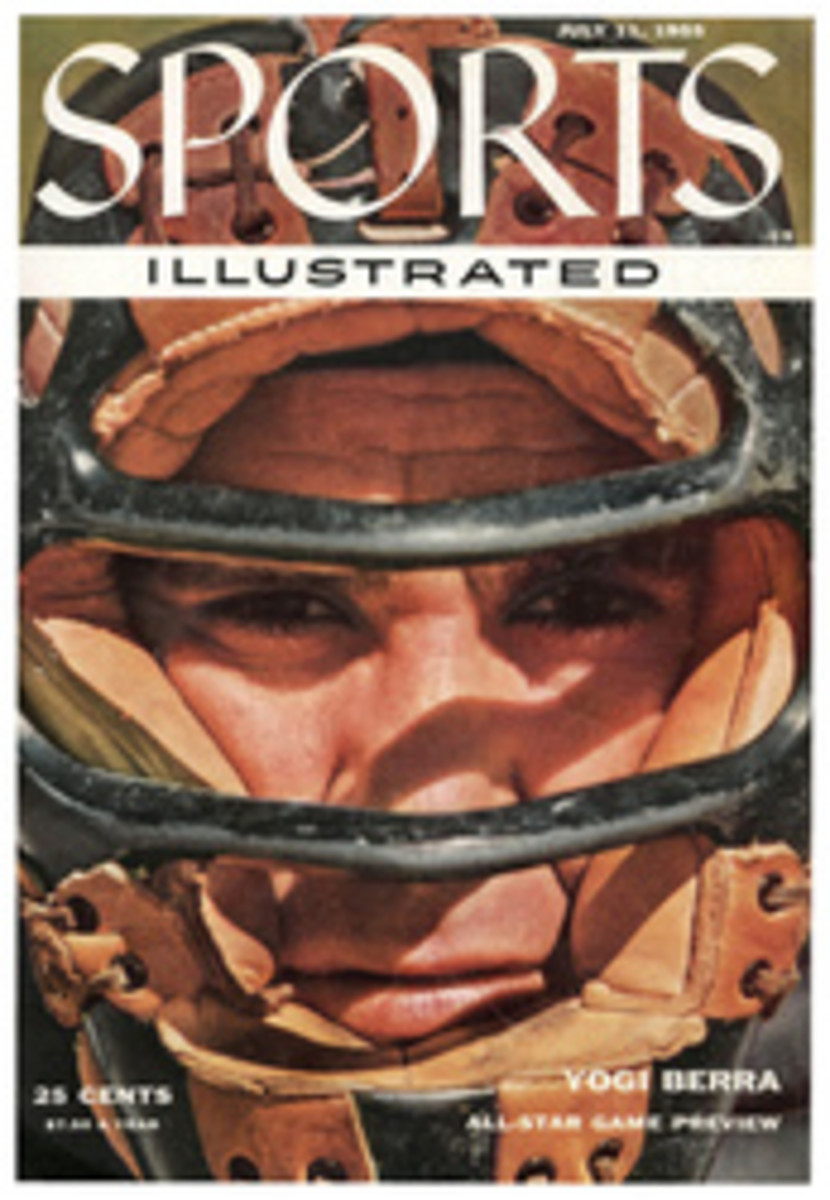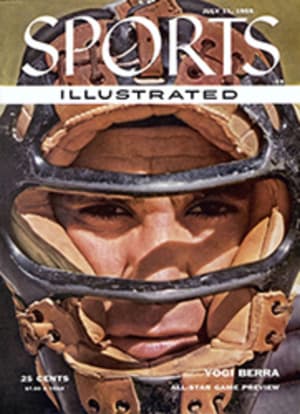
PREVIEW: STARLIGHT ON MILWAUKEE'S BIG YARD
When the All-Star Game of 1934 opened in the Polo Grounds, Detroit's Charley Gehringer hit Carl Hubbell's fourth pitch for a single and ran to second base as Wally Berger fumbled in center field. With the game four pitches old, the American League had a runner in scoring position.
Pitching to Heinie Manush, Hubbell tried to shave the strike zone and missed four times. Now there were runners on first and second with none out. Waiting to bat were Babe Ruth, Lou Gehrig and Jimmy Foxx. The National League's beet-red catcher, Gabby Hartnett, trudged out to the mound.
"Hub," he said, "just throw that thing. It always gets me out."
Three times against Ruth, Hub threw that thing—his left-handed screwball. The Babe struck out. Gehrig got three. As he struck out, Gehringer and Manush worked a double steal. Right-handed Jimmy Foxx wore the half-smile of greedy anticipation which the sight of a left-handed pitcher always brought to his wide mouth. One of his three strikes was a foul, not very loud. The side was retired.
Starting the second inning, Al Simmons struck out. So did Joe Cronin, and then Bill Dickey singled. That's how they always tell the story of the most memorable individual performance in 21 All-Star Games. Never anything like it before or since, they say; five of the world's most dangerous batters polished off in a row.
Lefty Gomez, the historian, says they tell it wrong. Lefty was the American League's pitcher. After Dickey's single, Hubbell struck out Gomez, which was not quite the same as splitting the atom.
"My friend!" an embittered Gomez snarled at Dickey. "It's going down in history that Hub struck out five of the greatest hitters of all time. If you don't louse it up, it could be seven of the greatest—including Gomez."
Let's set the record straight. It wasn't Ruth, Gehrig, Foxx, Simmons and Cronin. It was Ruth, Gehrig, Foxx, Simmons, Cronin and Gomez.
In baseball's 21 midsummer circulation campaigns for the Chicago Tribune, other names besides Hubbell's have been celebrated, other games besides that second one have been memorable. There was the ninth, for example, played before 54,674 witnesses in Detroit's [Br ggs] Stadium.
Beaten in five of the first eight games, the Nationals led this one, 5 to 3, with one out in the latter half of the ninth inning. Arky Vaughan, of the Pirates, had batted in four runs with two homers and had added a single in the National League cause. Ted Williams had doubled home a run for the Americans, flied out and taken a called third strike.
After two singles and a walk filled the bases against Claude Passeau, Joe DiMaggio grounded into a force play that scored a run, cutting the Nationals' lead to 5-4 with one putout to go. Williams took two balls and a strike, then flexed his wrists.
With the possible exception of Henry Ford II, nobody in Detroit is closer to the Deity than the baseball writers, whose detention pen perches on the topmost rim of the stadium within a handshake of Heaven. The aerie is extended to right and left beyond both foul poles, and cash customers sit out there as upon Olympus.
When Williams flexed his wrists, the ball took off for Grosse Pointe. Seemed in a fair way to make it, too, until intercepted by a godling up there on the cornice of the sky. The American League had another, 7 to 5.
There was the night game of 1942 in the Polo Grounds, which began with a cloudburst and ended with a blackout. There was the time Hartnett, managing the Nationals, forgot he had Morrie Arnovich on the bench waiting for a chance as pinch batter, overlooked the Phillies' hero entirely and was denounced in Philadelphia as though he had betrayed Betsy Ross.
There've been games to remember and excitements to savor, but the thing isn't baseball. It's a theatrical pageant, a newspaper promotion stunt, a mere exhibition. Competition is the essence of baseball, and there can be no genuine competition when the rules require that a pitcher be replaced after three innings even if he is throwing a no-hitter. This is a parody of baseball, and not a funny one.
Generally speaking, baseball people dislike the All-Star Game. Players covet the distinction of making the team, are resentful if they aren't chosen, and don't want to play if they are because it costs them a midseason vacation. Club owners pale at the spectacle of high-priced bric-a-brac risking disabling injury at no profit to the employers. Baseball writers, intensely interested in the pennant races, are bored by an exhibition that has no bearing on a championship.
Nobody likes it except the public and Arch Ward. The latter, sports editor of the Chicago Tribune, made it all up out of his own head and sold the big leagues on it in 1933. The teams would be selected by vote of fans who read the Tribune or cooperating papers. For the first time ever, there'd be an opportunity to see all of the best players in the world on the field together.
It would be, Arch Ward insisted, a baseball fan's dream come true. (In that era of strong stomachs, the entertainment was called the "dream game.")
Arch Ward was right, as usual. The first game, July 6, 1933, in Comiskey Park, Chicago drew 49,200 paid admissions. The game has never drawn fewer than 25,534 fans, and the second biggest crowd of all, 68,751, was attracted last summer in Cleveland, which seems to indicate that the exhibition is gaining in popularity.
It will certainly sell out Milwaukee County Stadium this year, though that is no criterion because Charley Grimm could pack the joint with a banjo recital. Wisconsin fans have never seen Ted Williams or Yogi Berra, Al Kaline or Nellie Fox or Mickey Mantle. They'll swoon with the joy of it all, but they won't see a ball game.
To a baseball fan, though, it's a great day when he can go take his first look at a fellow like Kaline, the Detroit Tigers' flamboyant young outfielder. Chances are the fan has read about Kaline, and how the Tigers signed him for a bonus the day after he got out of Southern High in Baltimore.
Maybe they've read of his background, know that his grandfather was a barehanded catcher for Queenstown on the Eastern Shore ot Maryland and bred up three sons who were catchers in sandlot ball, including Al's father, Nicholas, who works in a Baltimore broom factory. Perhaps they don't know that Kaline's maternal grandfather and his mother's brother were sandlot players in Baltimore, and that his mother was no slouch herself at foot races and volleyball and dodge-the-ball in Baltimore's Clifton Park.
Then again, maybe they do know all that, because baseball tans have an incredible appetite for minutiae regarding their heroes. Anyhow, they haven't seen Kaline in Milwaukee, or Berra or Williams or Mantle, and they're going to love it.
Naturally, it's going to be something more than a mere exhibition game in Milwaukee. The whole week of the game has been designated as an "All-Star Festival," including, among other attractions: horse show, drama, polo game, movie première, women's baseball clinic, fireworks, Venetian night parade of boats, All-Star parade, music under the stars, PGA golf clinic, boxing, $35,000 open golf tournament, style show, folk festival, state tennis championships, American Legion 40 & 8 parade, outboard races, water frolic, drum and bugle corps contests, stock car races, art exhibit.
All this, and the All-Star Game, too. It won't matter to the fans, or not much, that the ballot boxes may be stuffed, the election rigged, and men chosen for some positions which they can't even hold on their own teams. That's how the democratic process works.
[originallink:10461971:42676]
PHOTO
COUNTY STADIUM, only 15 minutes from downtown Milwaukee, is one of baseball's most modern big parks. Its dimensions are modern too: 320 feet down the left-field line, 402 to dead center, 315 feel to right field.
VITAL STATISTICS
EVENT: 22nd All-Star Game
PLACE: Milwaukee County Stadium
DATE: Tuesday, July 12
GAME TIME: 1:30 p.m., Central Standard Time
TRANSPORTATION: By automobile—Wisconsin Ave. to Blue-mound Road directly to main entrance; by bus—Stadium Special direct to Stadium from Wisconsin Ave.; by trolley—No. 10 Wells St. car to within two blocks of Stadium.
BROADCAST: Air time 1:15 p.m., C.S.T. for 60 million radio (Mutual) and television (NBC) audience.
RECORDS: American League leads series 13-8. Largest crowd: 69,812 at Cleveland's Municipal Stadium, 1935. Highest net gate receipts: $259,204, Municipal Stadium, 1954.
PROCEEDS: Net receipts from ticket sales (45,000 tickets priced from $1.50 to $7.50) and $110,000 radio and TV rights go into Central Fund, which pays big part of players' annuity plan. Total receipts to date: $1,481,126.

